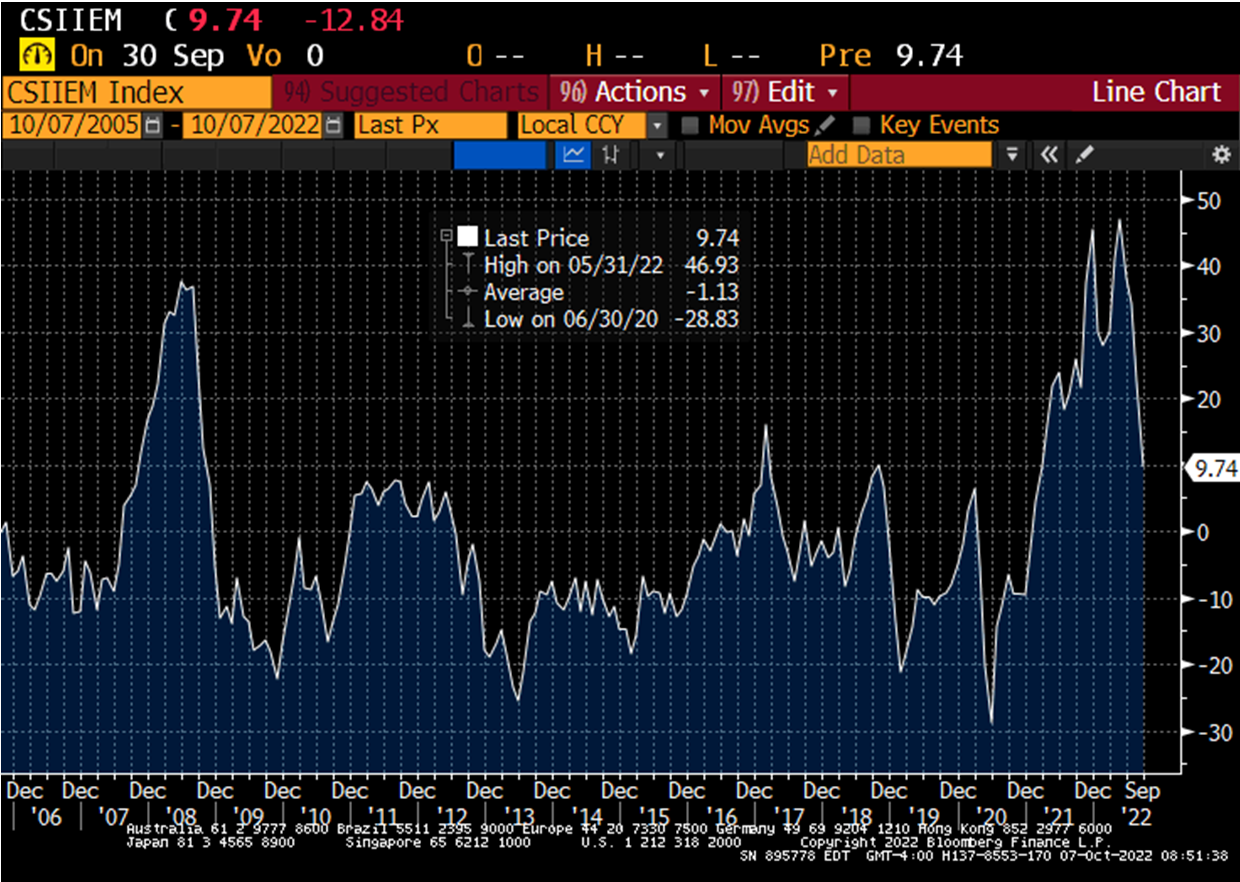EM Inflation Surprises – New Hope
07 October 2022
Read Time 2 MIN
EM Price Pressures
The inflation surprise index for emerging markets (EM) keeps improving (see chart below), with Mexico and Chile joining three Asian economies (Indonesia, South Korea, and Thailand) on this week’s downside surprise list. Granted, inflation surprises in Mexico and Chile are too small to justify a pause in the tightening cycles. Further, headline and core inflation in both countries are significantly above their respective targets. This is the reason why the market continues to price in more rate hikes – a +50bps move in Chile next week and +75bps in Mexico in early November. However, if the disinflation trend is confirmed, central banks can safely slow the pace of tightening later on.
LATAM Rate Hikes
Chile and Mexico’s regional peer – Peru – is already in this position. The central bank was perfectly content with a small 25bps hike yesterday. But this is not the end of the cycle. An important reason why Peru will continue tightening for some time is because inflation expectations are still elevated. The fact that they are trending down, however, allows to proceed in small steps. An additional consideration is that Peru’s ex–ante real policy rate (adjusted by expected inflation) is already positive – an indication that the policy stance is getting more restrictive against the backdrop of the weaker growth outlook.
EM Asia Growth and Policy Rates
One question we keep asking ourselves is whether EM Asia would be able to avoid the high inflation “curse” that scarred this year’s economic backdrop in Emerging Europe and LATAM. Asia’s regional inflation wave started later, giving central banks more time to remain accommodative, and the latest inflation releases suggest that the inflation momentum might already be easing just below the previous regional inflation peak in 2012–2013 (which is not the case in either EM Europe or LATAM). Does this mean that Asian central banks are in a better position to deal with the global growth slowdown? We hope to get more insights at the IMF Annual Meetings in Washington DC next week. Stay tuned!
Chart at a Glance: EM Inflation Surprises Trending Lower

Source: Bloomberg LP.
Related Insights
IMPORTANT DEFINITIONS & DISCLOSURES
This material may only be used outside of the United States.
This is not an offer to buy or sell, or a recommendation of any offer to buy or sell any of the securities mentioned herein. Fund holdings will vary. For a complete list of holdings in VanEck Mutual Funds and VanEck ETFs, please visit our website at www.vaneck.com.
The information presented does not involve the rendering of personalized investment, financial, legal, or tax advice. Certain statements contained herein may constitute projections, forecasts and other forward looking statements, which do not reflect actual results. Information provided by third-party sources are believed to be reliable and have not been independently verified for accuracy or completeness and cannot be guaranteed. Any opinions, projections, forecasts, and forward-looking statements presented herein are valid as of the date of this communication and are subject to change without notice. The information herein represents the opinion of the author(s), but not necessarily those of VanEck.
The views contained herein are not to be taken as advice or a recommendation to buy or sell any investment in any jurisdiction, nor is it a commitment from Van Eck Associates Corporation or its subsidiaries to participate in any transactions in any companies mentioned herein. This content is published in the United States. Investors are subject to securities and tax regulations within their applicable jurisdictions that are not addressed herein.
All investing is subject to risk, including the possible loss of the money you invest. As with any investment strategy, there is no guarantee that investment objectives will be met and investors may lose money. Diversification does not ensure a profit or protect against a loss in a declining market. Past performance is no guarantee of future results.
